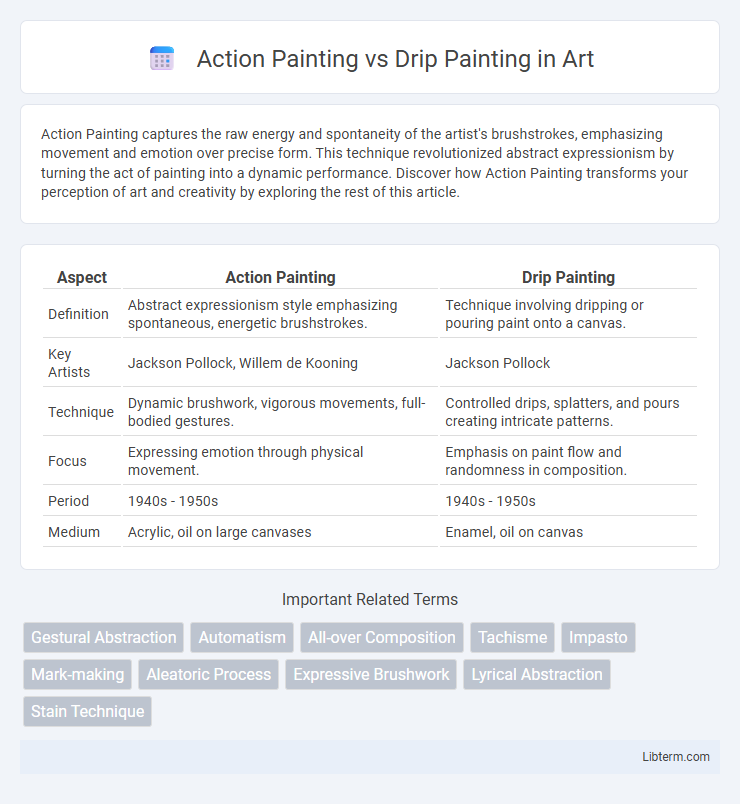Action Painting captures the raw energy and spontaneity of the artist's brushstrokes, emphasizing movement and emotion over precise form. This technique revolutionized abstract expressionism by turning the act of painting into a dynamic performance. Discover how Action Painting transforms your perception of art and creativity by exploring the rest of this article.
Table of Comparison
| Aspect | Action Painting | Drip Painting |
|---|---|---|
| Definition | Abstract expressionism style emphasizing spontaneous, energetic brushstrokes. | Technique involving dripping or pouring paint onto a canvas. |
| Key Artists | Jackson Pollock, Willem de Kooning | Jackson Pollock |
| Technique | Dynamic brushwork, vigorous movements, full-bodied gestures. | Controlled drips, splatters, and pours creating intricate patterns. |
| Focus | Expressing emotion through physical movement. | Emphasis on paint flow and randomness in composition. |
| Period | 1940s - 1950s | 1940s - 1950s |
| Medium | Acrylic, oil on large canvases | Enamel, oil on canvas |
Introduction to Action Painting and Drip Painting
Action Painting emphasizes dynamic brushstrokes and spontaneous gestures, reflecting the artist's physical interaction with the canvas to convey emotion and movement. Drip Painting, a subset of Action Painting popularized by Jackson Pollock, involves dripping or pouring paint onto a horizontal surface, creating intricate patterns through controlled randomness. Both styles revolutionized Abstract Expressionism, focusing on the creative process rather than precise imagery.
Historical Background and Origins
Action Painting emerged in the 1940s as a dynamic form of Abstract Expressionism, pioneered by artists like Jackson Pollock and Willem de Kooning in New York City, emphasizing spontaneous, gestural brushwork. Drip Painting, a subset of Action Painting popularized by Pollock in the late 1940s, utilized the technique of dripping or pouring paint onto canvases laid on the ground, breaking traditional brushstroke methods. Both styles reflect the post-World War II American art movement's shift toward expressing subconscious emotion through physical engagement with paint and surface.
Key Artists in Action Painting
Key artists in Action Painting include Jackson Pollock, Willem de Kooning, and Franz Kline, who emphasized dynamic brushstrokes and spontaneous gestures to capture the energy of creation. Pollock is particularly renowned for pioneering Drip Painting, a technique characterized by dripping or pouring paint onto a canvas laid on the floor, blending process and product. Willem de Kooning's vigorous brushwork contrasts with the more fluid, rhythmic patterns found in Drip Painting, highlighting the diverse approaches within Abstract Expressionism.
Key Artists in Drip Painting
Drip painting, characterized by the dynamic application of paint through dripping and pouring techniques, is most famously associated with Jackson Pollock, whose innovative style defined Abstract Expressionism in the mid-20th century. Other key artists in the drip painting movement include Helen Frankenthaler, who introduced the soak-stain technique blending drip methods with color field painting, and Sam Francis, known for his vibrant use of dripped and splattered paint to create energetic compositions. These artists expanded the expressive potential of drip painting beyond traditional action painting, emphasizing spontaneity and gesture in modern art.
Techniques and Materials Used
Action Painting employs vigorous brushstrokes and dynamic movements, using thick oil or acrylic paints applied directly onto large canvases to emphasize spontaneity and physical engagement. Drip Painting, pioneered by Jackson Pollock, involves dripping or pouring liquid enamel or oil-based paints onto horizontal surfaces, relying on gravity and controlled motion to create intricate webs of color. Both techniques prioritize the physical act of painting but differ in tool usage--brush versus stick or drip--and paint viscosity, influencing texture and visual impact.
Differences in Artistic Process
Action Painting emphasizes energetic brushstrokes and physical gestures, capturing the artist's dynamic movement on the canvas. Drip Painting involves controlled dripping or pouring of paint, creating intricate patterns through gravity and fluid dynamics rather than direct hand movements. The key difference lies in Action Painting's tactile engagement versus Drip Painting's reliance on paint manipulation and surface interaction.
Visual Characteristics and Styles
Action Painting emphasizes dynamic, gestural brushstrokes that convey the artist's physical movement and emotional intensity, often resulting in bold, textured surfaces with visible traces of rapid application. Drip Painting features the controlled yet spontaneous dripping or pouring of paint onto the canvas, creating intricate networks of fluid lines and splatters that emphasize rhythm and movement while minimizing direct brushwork. Both styles capture the essence of Abstract Expressionism but differ in technique: Action Painting highlights vigorous hand gestures, whereas Drip Painting relies on gravity and fluid dynamics to shape the composition.
Influence on Abstract Expressionism
Action Painting, characterized by dynamic brushstrokes and spontaneous gestures, significantly shaped the core ethos of Abstract Expressionism by emphasizing the artist's physical engagement with the canvas. Drip Painting, pioneered by Jackson Pollock, introduced a revolutionary technique of dripping and splattering paint that expanded the movement's exploration of automatism and chance. Both styles collectively deepened Abstract Expressionism's focus on emotional intensity and individual expression through innovative methods of paint application.
Cultural and Critical Impact
Action Painting revolutionized the art world by emphasizing the artist's physical engagement and emotional intensity, influencing Abstract Expressionism's cultural narrative and critical discourse. Drip Painting, a technique popularized by Jackson Pollock, challenged traditional artistic boundaries through its spontaneous and dynamic application of paint, provoking debates on authorship and the role of chance in creativity. Both styles critically impacted modern art by redefining artistic process and expression, shaping cultural perceptions of originality and artistic freedom.
Legacy and Relevance Today
Action Painting, epitomized by artists like Jackson Pollock, revolutionized abstract expressionism by emphasizing dynamic, spontaneous brushstrokes that conveyed raw emotion and energy, maintaining a lasting legacy in contemporary art through its influence on performance and process-oriented works. Drip Painting, a subset of Action Painting popularized by Pollock's unique technique of dripping and pouring paint, continues to resonate today as a symbol of artistic freedom and innovation, inspiring modern multimedia and installation art practices. Both styles remain relevant, shaping current dialogues around creativity, authenticity, and the physical act of painting in the 21st century art world.
Action Painting Infographic

 libterm.com
libterm.com